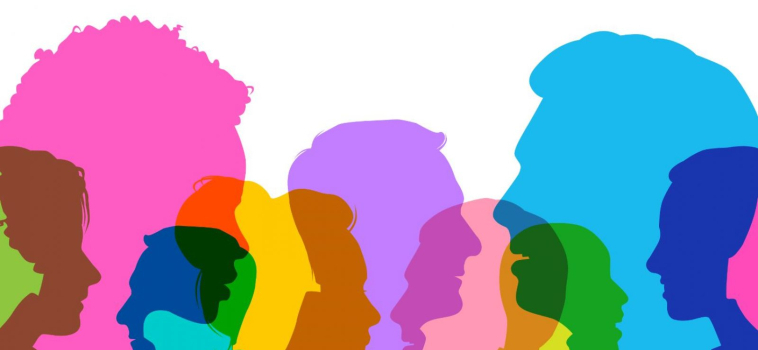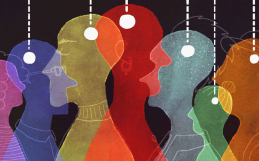Diversity, Equity and Inclusion in Experiential Learning
Good for Business
Diversity of perspectives and inclusive workplace culture is simply good for business. According to Josh Bersin, employee diversity leads to better business results because “companies that embrace diversity and inclusion in all aspects of their business statistically outperform their peers.” When McKinsey compared profits of companies ranked according to their ethnic diversity in 2014, those at the top were 33% more likely to see higher-than-average gains, while the minor gender and ethnically diverse firms were 29% more likely to underperform in terms of profits. The following year their expanded “Diversity Matters” study found that ethnically-diverse companies were more likely to perform 35% better and gender-diverse companies were more likely to achieve 15% better. This article discusses embedding diversity and inclusion in experiential learning approaches for leadership development programs.
Diversity as a Powerful Resource
Diversity, equity, and inclusion are potent resources that fuel innovation and increase productivity. Creativity and collaboration, crucial to competing in today’s markets, flourish in companies that cultivate psychological safety and build a work environment and culture where everyone’s opinions and ideas are valued. A 2017 Boston Consulting Group study looked at 1700 different companies across nine other countries and found that those with more diverse management teams had higher revenue due to innovation.
Despite generational variations in understanding of what constitutes workplace diversity, equity, and inclusion, many agree that it encompasses understanding, accepting, and valuing differences between people not only in terms of race, ethnicity, gender, age, religion, disability, and sexual orientation, but also differences in education, personalities, skill sets, experiences, and knowledge base.
“An ideal organization is one in which each worker’s potentialities find room for expression.” – Csikszentmihalyi, Good Business
To achieve a competitive business advantage and success, diversity, equity, and inclusion must be part of a company’s mission and a top-to-bottom business strategy, not just another HR program. Diversity and inclusion are practices desired by everyone. When incorporated into well-executed and value-based leadership development programs, they become strategies that enable people managers to leverage the effects of diverse perspectives, backgrounds, and skills.
Why Leadership Development Should Focus on This Topic
Leaders have an enormous impact on how things are done. Ultimately, the leader is responsible for instilling a culture that provides equal access to opportunity for everyone in an environment where all feel entirely accepted and valued for exactly who they are. Inclusion and diversity are best measured by how employees experience a sense of belonging and connectedness to their company’s purpose and people. When employees feel they can be themselves and bring their whole selves to work, they perform at their best.
“Getting employees to give their best is a way to make it possible for them to grow as individuals.” – Csikszentmihalyi, Good Business.
Decades of research originated by professor Mihaly Csikszentmihalyi that have explored optimal performance, the mental state of Flow, and its effects on employee engagement and team effectiveness, support the notion that it is possible and advisable for companies to create an environment where employees can do their best work. Learning to navigate relational dilemmas at work is a big part of this equation. Cohesive teams can resolve conflicts effectively so they can focus on the task at hand and get back to being productive despite differences of opinion. Online leadership development programs (with extended blended learning support) like FLIGBY, which stress emotional intelligence, and center around values that support inclusion, diversity, and teamwork, can provide the much-needed foundation as well as a risk-free, experiential testing ground where managers can experiment with decision-making and navigating difficult situations.
Diversity, Equity and Inclusion in FLIGBY
Today’s leadership development programs must cultivate emotional intelligence skills that support inclusive behaviors and reflect values consistent with the appreciation of diversity. Similarly, practical and realistic virtual learning environments, like the FLIGBY simulated reality, must reflect a diverse and inclusive workplace. Inclusivity is more than just the “right” thing to do—it will set our teams up for success or failure. Research shows that diverse groups are better at making decisions than individuals 87% of the time, and various organizations outperform competitors by 35%.
How to Implement Diversity and Inclusion in Experiential Learning
During the project development stage for FLIGBY more than eight years ago, we realized that addressing diversity, equity, and inclusion was essential if we were to create an experiential learning field for managers that was consistent with workplace reality and one that was compatible with the Flow-promoting Leadership philosophy and with Csikszentihalyi’s Good Business values.
“Today, business leaders are among the most influential members of society. While they are all trained to generate profits, many of them are oblivious to the other responsibilities that their new societal leadership entails.” – Csikszentmihalyi, Good Business
To that end, our FLIGBY’s architects initially set out to present the relational conflicts in the Game as dynamic and realistic as possible. While game-based learning is one of the most sophisticated and effective forms of leadership development available today, diversity and inclusion are complex topics to teach. We realized that the many situational dilemmas that our Game is about could make us vulnerable to common traps like oversimplifying and failing to stay firmly planted within our framework of values of Good Business when presenting leadership techniques. The avoid these traps, we designed our content development strategy around the following considerations:
1. Focusing on what counts
The most significant dilemma we faced when designing the Game was addressing exclusion and discrimination in the workplace without potentially encouraging racial stereotyping while still honoring our values that make such behaviors unacceptable to FLIGBY’s global and multicultural team. We realized that if the characters in our Game exhibited, for example, some negative personality traits or patterns of behaviors and were at the same time representatives of specific ethnicities, this could be misconstrued as us saying that certain racial groups were typically behaving in this way. We realized that if any of the characters belonged to a different race or ethnic group, then the many conflicts that the Game is about, none of which have to do with race, might be blurred by possible racial interpretations.
“The main task of a manager is to get people to work together efficiently. An ideal organization is one in which each worker’s potentialities find room for expression.” – Csikszentmihalyi, Good Business
We had to ask ourselves what counts, how to address diversity and inclusion at their core, and how to ultimately make the most difference when embedding those values into an experiential leadership development program. To be able to show the realistic consequences of unethical managerial behavior, we decided that interpersonal conflicts would be presented among a multicultural but ethnically homogeneous group of people so we could avoid stereotyping of different ethnic groups.
Our decision to focus on unethical workplace behavior rather than its many causes gave us more bandwidth to fine-tune the existing diversity elements in FLIGBY. The Game’s dynamic storyline engages the players in interactions with game characters through typical interpersonal workplace conflict scenarios. It allows them to solve complex situational dilemmas that impact others across all differences, from age and gender to perspective and background. The skills and competencies necessary to navigate decisional points in many diverse contexts in the simulation are reflected in the Game’s scores, individual player profiles, and reports.
Of the 29 Flow-Leadership Skills measured in FLIGBY, some of the most relevant to the cultivation of diversity and inclusion in leadership development include active listening, communication, engagement and trust, conflict management, delegating, diplomacy, emotional intelligence, empowerment, feedback, social system thinking, social responsibility, and teamwork.
As we continue to improve our reporting capabilities, and in response to the increased interest in measuring competencies that align with diversity and inclusion, we are currently working on separating those behaviors and decision-making points in our Game that are reflective of an open-minded, inclusive, and collaborative mindset. We plan to revise these metrics in our next upgrade to the reporting tool and our game-based profiling to specifically address inclusion and diversity as a separate part of the scores index to benefit those who want to address those elements in their leadership development assessment and planning.
We are also taking another look and evaluating the benefits of introducing more ethnically diverse characters into the new version of the game. We have consulted many of our partners and clients to understand this complex topic better from their perspective and to learn how they address these conflicts and challenges in their organizations. This will help us confidently decide how to introduce more racially diverse virtual team members in the upcoming sequel of FLIGBY while avoiding the common pitfalls of addressing complex issues shallowly.
2. Allowing to experience discomfort
FLIGBY launched eight years ago, and over the years, we’ve collected feedback from thousands of individuals across North America, Europe, Africa, and Asia. These rich experiences taught us a lot about the most common pitfalls when addressing diversity and inclusion in experiential learning.
In addition to failing to focus on what counts when it comes to diversity and inclusion in the workplace, failing to present interpersonal conflicts at work realistically has proven to be another major issue of concern. Many managers avoid calling out or bringing attention to destructive behavioral patterns or habits in the workplace. There is also pressure to reach an agreement, which often leads to interpersonal conflict at work needs to be addressed. Someone’s unmet needs are compromised in favor of moving forward, which inevitably causes trouble down the road. Many opportunities for learning and growth occur in those uncomfortable spaces of disagreement if we are willing to pay attention and invest time. It’s important to remember that when going gets tough, we often revert to our subconscious reactions and exhibit pre-programmed behaviors and biases. Leaders and all employees must be aware of the impact of those behaviors.
Suppose we want our leaders to be prepared for challenging situations. In that case, we have to allow them to experience the discomfort and let them live through real-life scenarios that test their managerial abilities and soft skills. The most effective way to develop emotional intelligence is experiential learning which entrenches us in difficult interpersonal situations and decisions that affect others. So crucial in addressing workplace dynamics and inevitable conflict, leadership development programs that focus on soft skills allow us to ask tough questions of ourselves as leaders and give us a chance to evaluate our level of self-awareness. Simulated business scenarios like those in FLIGBY remind us that it takes 2 for a relationship breakdown to happen and that there might be an area in our leadership approach where our teams would like to see us behave differently.
3. Diversity alone is not enough; you need inclusion
Leaders often set the example and are expected to role model inclusive behaviors and promote diversity through decision-making. Cultivating diversity without inclusion can worsen things and lead to more conflict when individuals are subjected to psychological pain caused by exclusion and ostracism. The best place to start is to become aware of the many forms of implicit bias that prevent us from seeing the whole person before us and acknowledging that this topic is much more complex than differences between races and ethnic groups.
Cultivating inclusion allows companies to respond more effectively to customers, attract and retain high-performing talent, and empower teams to collaborate better. Over time it raises productivity and delivers sustainable growth that has the potential to future-proof the business in today’s volatile markets. Companies with high inclusive engagement have operating profits almost three times higher than those without, according to a research study on 50 companies by Towers Watson.
4. Presenting leadership techniques within the proper framework of values
Diversity and inclusion are good for business and represent what it means to be doing and being a good business at the core. Presenting leadership techniques without the proper framework of values (like “Good Business” values) is no more than doing lip service to diversity and inclusion, which can often do more harm than good.
“The Good Business idea focuses on how leaders and managers and even the concerned employees of any organization can learn to contribute to the sum of human happiness, to the development of an enjoyable life that provides meaning, and to a society that is just and evolving.” – Csikszentmihalyi, Good Business
FLIGBY uses the principles of Flow-promoting Leadership, as described by Prof. Mihaly Csikszentmihalyi in his book Good Business: Leadership, Flow, and the Making of Meaning, to provide practical guidelines for creating a truly diverse and creative working environment. In essence, its philosophy promotes conducting business successfully and humanely.
“Good Business” principles are a solid, value-based foundation for creating diverse and inclusive organizations. Its basic philosophy does not permit people to advance at the expense of others. Here inclusion and diversity are best understood as applying two dialectically linked processes of integration and differentiation that lead to greater complexity.
“An organization that does good business is also concerned with the personal growth of its members. An evolving system is not static but tends toward complexity.” – Csikszentmihalyi, Good Business
Differentiation and integration go hand-in-hand. We strive to realize our highest potential and develop our uniqueness through differentiation. Yet, at the same time, through integration, we choose to identify with the more extensive processes at work in the world and deliberately look out for the benefit of others. Differentiation allows us to develop identity and self-actualize. At the same time, integration puts our potential to use toward creating harmony in the world and working toward something greater than ourselves, thereby transcending our consciousness for the betterment of humanity.
Conclusion: Learning By Doing
Learning by doing has never had a more critical application than teaching inclusivity and appreciation of diversity. Experiential leadership development programs like FLIGBY can simulate the conditions needed today for diversity and inclusion to become embedded in the fabric of the work design, culture, and leadership behaviors. Changing organizational systems and culture requires improving professional development and opportunities for advancement, leadership training, and decision-making.
One-off skills-building workshops don’t lead to culture change. Organizations must strive to curate experiential learning that helps transform their people and culture. To implement diversity and inclusion in experiential learning, leadership development programs must support participants in changing their minds, which is the first step to changing behavior.
Serious games like FLIGBY simulate leadership development opportunities for creating diverse teams of workers across roles and lines of authority and promise to improve those leadership skills necessary to navigate the ever more complex landscape of today’s managerial dilemmas.




